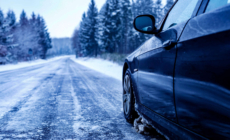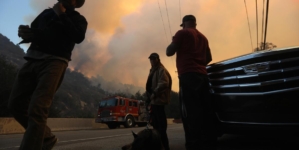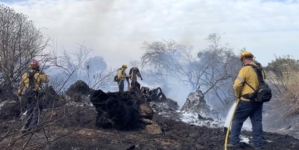-
DNA from cigarette helps identify suspect in 2003 cold case death of mother of 7 found in state park - 17 mins ago
-
Yankees fans who interfered with Mookie Betts’ World Series catch get indefinite ban - 23 mins ago
-
Gusty winds expected to return to Southern California on Sunday - 25 mins ago
-
Map Shows States Hit With ‘Very Dangerous’ Winter Ice Warning - 40 mins ago
-
Woman sentenced in ‘Slender Man’ stabbing granted conditional release from psychiatric facility - about 1 hour ago
-
False reports of immigration sweeps in Los Angeles spread amid wildfires - about 1 hour ago
-
2024 NFL Wild Card odds: Best bets for Chargers-Texans, Broncos-Bills - about 1 hour ago
-
Who Will Play in Super Bowl LIX? Here’s What an AI Supercomputer Predicts - about 1 hour ago
-
Mandy Moore tells critics to ‘kindly F off’ after backlash for sharing her family’s fire relief fundraiser - 2 hours ago
-
L.A. wildfire resource guide: How to stay safe, what to do and how to help - 2 hours ago
What to know about infectious diseases this holiday season
It’s that time of year, when families and friends come together to share their holiday cheer and a few circulating pathogens.
Peter Chin-Hong, an infectious disease specialist at UC San Francisco, said people should be on the lookout for the “Big Four”: three respiratory viruses currently moving through the U.S. — influenza, COVID-19 and RSV — and one stomach virus — norovirus.
According to WastewaterScan — an infectious disease monitoring network led by researchers at Stanford and Emory universities, with lab-testing partner Verily, Alphabet Inc.’s life sciences organization — those four viruses are running hot around the nation.
In the case of COVID-19, the half of the U.S. east of Montana, Wyoming, Colorado and New Mexico — is trending “high,” while the Western states are still generally low, with some hot spots in major cities such as San Francisco, Seattle, Salt Lake and Boise, according to WastewaterScan.
But that’s likely to change as holiday travel moves those viruses around in what Chin-Hong referred to as “the Great Holiday Equalizer.”
It’s flu, though, that is grabbing most physicians’ and researchers’ attention right now, he said.
While the federal Centers for Disease Control and Prevention‘s outlook for the severity of the flu‘s impact this season was low, Chin-Hong said he saw ominous signs coming from the typical bellwethers for the U.S.: the United Kingdom and South America.
In the UK, there were nearly four times the number of flu cases in early December than they were the same time last year. A similar trend occurred during the winter season in the South American nations of Chile, Ecuador and Uruguay, where hospitalizations were higher than in the 2023 flu season. Elsewhere on the southern continent, seasonal flu rates were fairly typical.
Chin-Hong suspects the CDC’s outlook is based on the assumption that people have some “carryover immunity” from last year, and he said vaccinations help.
But until flu season gets into full swing, it’s difficult to know exactly what it’ll look like and whether the vaccines have the circulating strains fully covered.
Chin-Hong said there are two predominant strains of the virus circulating: H1N1 and H3N2, with the latter virus associated with more severe disease, which may be causing the surges of hospitalizations abroad. But he said this year’s vaccine should cover it.
“It’s never too late” to get vaccinated, he said, noting that flu season in the U.S. is just beginning.
In addition, with the ominous threat of H5N1 bird flu simmering in the background, there is concern that it could mix with a human seasonal flu. Getting vaccinated and keeping the seasonal flu at bay, he said, will decrease the chances for such an occurrence.
Researchers and health officials say there is no evidence that H5N1 can be transmitted between people. But to keep extra safe as the virus moves through the nation’s dairy herds and commercial poultry operations, people should avoid raw milk, raw eggs and undercooked meat. Pasteurization and proper cooking techniques inactivate the virus.
But it’s not only the flu that’s threatening to dampen the nation’s good tidings.
COVID-19, RSV and norovirus are also prevalent.
COVID-19 has recently begun to show up in high levels in municipal wastewater, but Chin-Hong said that doesn’t necessarily mean we’ll see a surge in hospitalizations. Indeed, while the number of COVID cases is ticking up, the CDC predicts there will be fewer cases in the U.S. this year than in 2023.
“Some people think the reason why people are not getting it as much this year is because we got it so recently, particularly in California, and so that carryover immunity is kind of protecting us, at least for the time being,” Chin-Hong said. “The other hypothesis is that we just had enough cycles of it in the population, so maybe it kind of is low this year.”
But, he said, COVID has proven itself a nimble and adaptable virus, continually spawning recombinant variants, so “coupled with low vaccination rates, that’s always the fear with COVID, that it’ll surge back.”
The best things one can do to avoid the three respiratory viruses — influenza, COVID and RSV — is to follow “The three V’s: Vaccinate, ventilate and wash your hands very often,” he said. If you must be indoors or in close proximity to others, masks do make a difference. But try to mingle and cavort outdoors or in well-ventilated areas.
As for norovirus, which causes gastrointestinal distress and typically spreads via items handled by multiple people — such as airplane trays, handrails and buffet serving spoons — washing your hands is key. In addition, keeping your hands away from your face is critical; that’s the primary route of infection.
Chin-Hong said norovirus is seemingly everywhere these days.
“Anecdotally, a lot of colleagues of mine have been out with it,” he said.
In addition, there is some rhinovirus (common cold), pertussis and walking pneumonia circulating, he said.
And of course, he said, if you’re not feeling well, stay home. Nothing stops a virus or contagious bacteria is its tracks like keeping isolated — even if it means missing out on holiday revelries.
Source link


























